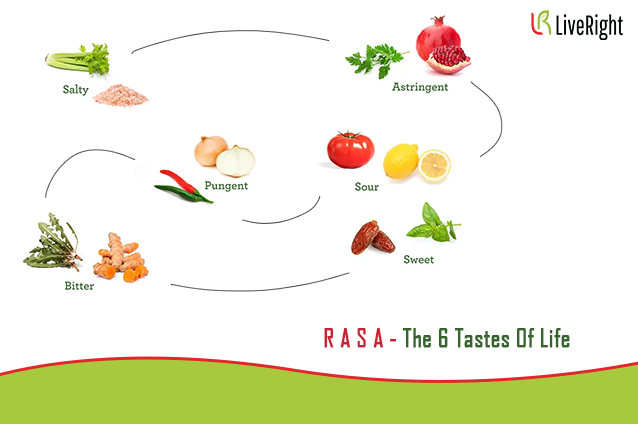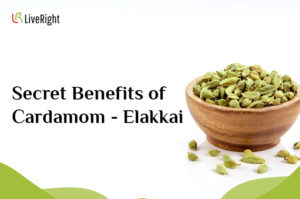Taste is the sensation perceived in the mouth & throat on contact with the taste buds in the oral cavity. Taste plays a vital role in food science and nutrition.
A single substance possesses one or more than one taste. There’s more to this than meets the tongue. So, when you eat something, the tongue is bombarded with tastants which are distinguished by the brain and exhibits various functions.
In Ayurveda, “Rasa” is a basic term for Taste but it has a deeper principle. The sensation which is perceived by Rasendriya (Tongue or taste receptors) is Rasa. In Ayurveda, the properties of the food or herbs are perceived by their taste.
Every taste has its own significance. Every taste possesses certain properties which are exhibited in the body and are essential for normal physiological functions of the body. For Example: Amla Rasa has digestive and appetizing properties.
The property of the food may not be completely dependent on the rasa but it is one of the key factors. Each rasa affects Trisdoshas.
It is responsible for the balance of Vata, Pitta & Kapha which is important for the physical as well as mental health. It is known fact how certain foods make a positive impact on the body and hence flavours of food should be picked wisely.
According to Ayurveda, there are six types of rasas known as Shadrasa (Shad means six):
1. Madhur Rasa (sweet)
2. Amla Rasa (sour)
3. Lavan Rasa (salty)
4. Tikta Rasa (bitter)
5. Katu Rasa (pungent)
6. Kashaya Rasa (astringent)
An ideal balanced diet consists of a meal with all the six rasas. A food substance can dominate one single taste or be a combination of 2-6 tastes. Keeping all the permutations and combinations, there is the total of 63 different tastes. So, a substance with all six tastes is considered to be the most potent.
According to ancient philosophy, all substances in the universe are composed of five elements i.e Panchmahabhutas. Similarly, every taste represents properties of these elements.
Nowadays, food is distinguished in Macronutrients i.e Carbohydrates, Protein, Fats and other micronutrients like vitamins and minerals. These can be paralleled to the Shadrasa. Just like nutrients, excess or deficiency of any rasa can lead to disease.
Madhur Rasa
Madhur means sweet. It is made from the elements Earth & Water. Sweet is a pleasant flavour represents love, calm and compassion. It is cooling in nature We eat sweets on special occasions as an act of expressing joy and happiness.
The body is accustomed to this taste since birth. It gives nourishment to the tissues. Hence, it is essential for children, old and malnourished. It improves complexion, hair quality and nails. It gives instant energy to the weak, strengthens sense organs and enhances the Immune system. Sweet substances aggravate Kapha and alleviate Vata & Pitta.
Sugars like glucose, fructose, maltose and lactose are all sweet.
Foods: Milk, Ghee, Coconut, Banana, cucumber, Rice, Wheat, Almonds
Medicinal Plants: Yashtimadhu (Glycyrrhiza Glabra), Shatavari (Asparagus racemosus), Bala (Sida Cordifolia)
Excess: When an excess of sweet food is consumed it leads to heaviness, unctuousness and lethargy. It reduces the Agni (Digestive acids), increases mucous and congestion. This lead to the formation of ama (toxins) in the body. It may cause diseases like fever, obesity, Diabetes Mellitus etc.
Amla Rasa
Sour taste is known as Amla rasa. It is made from the elements Earth & Fire. It is a comforting flavor when taken in right quantity. It also helps in the stimulation of Agni and acts as an Appetizer. Amla Rasa is unctuous and has fluid promoting properties. The excellent antioxidant properties found in this rasa is very commonly used as a detoxifying agent.
Amla Rasa is essential for absorption of some of the micro-nutrients like Calcium. The sour taste, also known as digestive fire, promotes liver function and also neutralizes the acids in the stomach. It aggravates Kapha & Pitta and balances Vata.
When amla rasa is consumed in excess it leads to burning sensation in chest. So try to keep the intake at balanced level.
Natural acids like Citric, Malic, Ascorbic, Oxalic and Lactic acid are sour
Foods that contain Amla Rasa: Lemon, Tomatoes, Yogurt, Vinegar, All Fermented Foods
Medicinal Plants: Amlaki (Emblica Officinalis), Dadima (Punica Gratum), Amlavetas(Garcinia pedunculate)
Excess: Excessive consumption of amla rasa can cause loss of strength, pallor and swelling. It leads to diseases like Anaemia, Ulcers, Acne, Urticaria and other skin diseases.
Lavana Rasa
Lavana means salty. Salty flavour is a taste enhancer. It is made from fire and water elements. It is moist and hot in nature. It liquefies mucus and clears channels. It instantly hydrates & creates moisture in the body when consumed and therefore, is commonly used for dehydration. It aggravates Pitta & Kapha and balances Vata.
Salts like sea salt, rock salt, pink salt
Food: Seaweed, Celery, Soy Sauce
Medicinal plants rarely possess lavana rasa. Shilajit is one of the Ayurveda medicine which is salty in taste.
Excess: A little of salt in the diet is important for life but a little extra can lead to a number of diseases. Excess use of salty foods causes premature greying of hair, wrinkles and baldness. It causes water retention leading to oedema and high blood pressure. Long-term consumption of excess salts causes lacerations, bleeding disorders and skin diseases.
Tikta Rasa
Tikta means bitter. A blend of air and space elements. This flavour is a therapeutic boon. It is disliked by many but has numerous therapeutic properties. It is light, dry and cool in nature.
They usually have anti-bacterial, anti-inflammatory and anti-pyretic properties. It cures anorexia by enhancing the release of digestive secretions and enzymes. It acts as an antidote and eliminates toxins from the body. It cures nausea, burning sensation and skin diseases. It mitigates Pitta and Kapha.
It is found in Sesquiterpenes, Anthraquinones, Alkaloid and some Glycosides.
Food: Leafy vegetables, Sesame seeds, Coffee, Turmeric, Cumin
Medicinal Plants: Neem (Azadirachta indica), Kutki (Picrorhiza kurroa), Guduchi (Tinospora Cordifolia)
Excess: Excess of bitter foods leads to nausea, dry mouth and dizziness. It causes wasting of tissues which lead to debility. It weakens the kidneys and lungs and also leads to Vata disorders.
Katu Rasa
Katu means pungent taste and is found in spicy foods. It is predominantly made of fire and air elements. It enhances the flavour of the food. It warms up the body and clears the throat and sinuses. It alleviates Kapha and helps to liquefy Kapha. It also increases circulation, encourages sweating, eliminates itching, clears toxins, cleanses the blood and the muscles, reduces cholesterol, opens the internal channels, and clears blockages.
Aromatic volatile oils, Resins, Oleo-resins and Mustard glycosides are all pungent in taste.
Food: Chilies, Garlic, Onions, Spinach, Mustard seeds, Black pepper, Ginger
Medicinal Plants: Fennel (Foeniculum vulgare), Pippali (Piper Longum), Adraka (Zingiber officinale)
Kashaya Rasa
Kashaya means astringent. This flavour is the driest of all the tastes. It contracts the whole mouth and draws mucous membrane closer together. It absorbs excess moisture and stimulates absorption. It promotes clotting and healing. It is therapeutically used to treat hyperhidrosis, leucorrhoea, diarrhoea, enuresis. It aggravates Vata and alleviates Kapha and Pitta.
Tannins in plants are found to be astringent in taste
Food: Broccoli, Lettuce, Sprouts, Beans, Coriander, Turmeric
Medicinal Plants: Guggul (Commiphora Mukul), Haritaki (Terminalia chebula), Arjuna (Terminalia arjuna)
Excess: Excessive consumption of astringent taste causes indigestion, dry mouth and flatulence. It causes spasms, insomnia, malaise and infertility.
Food Rituals:
According to Ayurveda, meals should be started with sweet foods and then moved to other tastes. It is contrary to what people follow but quite effective. Sweets are heavy to digest. At the start of the meal the Agni of the body is strongest, so if sweet is consumed, it gets digested easily and also gives nourishment to the tissues. Then Lavana ,and Amla Rasa should be consumed to, stimulate digestion and enhance the flavours. In the end, Katu and Kashaya rasa are taken which triggers absorption and clears palate.
Rasa is just one of the fundamentals of food. There are various other factors which influence the physiological functions of the body. Ayurveda believes that every taste should be savoured as they feed our body, mind and soul.
About Author:
Dr. Ritika Shah is an Ayurveda Consultant. She has done her graduation & MD in Ayurveda. She has completely dedicated herself to this ancient science of healing. She has worked on various research projects based on Ayurveda formulations and has a keen interest in the rare formulations of ancient science. She has immense faith in Ayurveda but is also well updated with the latest development in medical science.




